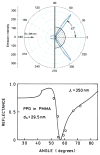Surface Plasmon-Coupled Ultraviolet Emission of 2,5-Diphenyl-1,3,4-oxadiazole
- PMID: 20725614
- PMCID: PMC2923458
- DOI: 10.1021/jp047136u
Surface Plasmon-Coupled Ultraviolet Emission of 2,5-Diphenyl-1,3,4-oxadiazole
Abstract
We studied surface plasmon-coupled emission (SPCE) of 2,5-diphenyl-1,3,4-oxadiazole (PPD) using a 20 nm aluminum film deposited on a quartz substrate. The directional SPCE UV fluorescence occurs within a narrow angle at 57° from the normal to the coupling hemicylindrical prism. This radiation is almost completely p-polarized, consistent with its origin from surface plasmons. These surface plasmons are induced by excited PPD molecules. The coupling of excited fluorophore dipoles with the aluminum is highly efficient, exceeding 50%. Different fluorescence emission wavelengths are emitted at slightly different angles on the prism, providing intrinsic spectral resolution. SPCE fluorescence on thin aluminum films can be used with many UV absorbing and emitting fluorophores.
Figures








References
-
- Liedberg B, Lundstrom I. Principles of biosensing with an extended coupling matrix and surface plasmon resonance. Sens Actuators, B. 1993;11:63–72.
-
- Frey BL, Jordan CE, Kornguth S, Corn RM. Control of the specific adsorption of proteins onto gold surface with poly(L-lysine) monolayers. Anal Chem. 1995;67:4452–4457.
-
- Salamon Z, Macleod HA, Tollin G. Surface plasmon resonance spectroscopy as a tool for investigating the biochemical and biophysical properties of membrane protein systems. I: Theoretical principles. Biochim Biophys Acta. 1997;1331:117–129. - PubMed
-
- Liebermann T, Knoll W. Surface plasmon field-enhanced fluorescence spectroscopy. Colloid Surf. 2000;171:115–130.
Grants and funding
LinkOut - more resources
Full Text Sources
